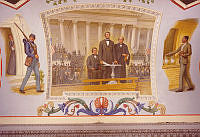Rubenstein Center Scholarship
John Gadsby: Hotelier and Slave Owner in the President's Neighborhood
This article is part of the Slavery in the President’s Neighborhood initiative. Explore the Timeline
For nearly four decades until 1836, John Gadsby was the premier hotelier of Alexandria, Baltimore, and Washington, D.C. He leased and operated the City Hotel and Tavern in Alexandria, as well as, the Indian Queen in Baltimore, and ended his career in Washington, D.C. with the Franklin House and the highly esteemed National Hotel. His hotels were considered state of the art, where guests could indulge in creature comforts such as hot and cold baths, mail services, and reading rooms. Gadsby’s hotels were equipped with an army of staff, both free and enslaved, to attend to guests’ every need. One traveler wrote of the National Hotel in 1833, “We stopped at Gadsby’s, the most celebrated hotel in the city... Mr. G is gentleman of the old school.... his house is admirably well managed and the servants numerous and attentive”.1
At his prestigious hotels, John Gadsby catered to the social elite, including American presidents. He held birthnight balls in honor of George Washington’s birthday at the City Hotel and Tavern in Alexandria. Here he entertained Thomas Jefferson and even purchased fine wines for Jefferson.2 Famously, Andrew Jackson sought refuge in the National Hotel after escaping through a White House window once the raucous inaugural festivities at the Executive Mansion proved to be too much for the new president. Click here to learn more about the enslaved households of President George Washington, President Thomas Jefferson, and President Andrew Jackson.

After a much-lauded career, Gadsby announced his retirement in 1836 and moved with his family and at least twenty enslaved domestic servants into Decatur House on Lafayette Square.3 He continued to be a popular figure in the neighborhood, holding many well-attended parties. However, not all guests thought highly of their host. In 1840, Adolphe Fouirer de Bacourt, a French diplomat, attended one of Gadsby’s soirees and registered his disgust with his host in private letters that were published years later.
Some days ago, I went to an evening party at Mr. Gadsby's, the proprietor of the hotel where I stayed on my arrival here, which he has relinquished to his son. He is an old wretch who has made his fortune in the slave trade, which does not prevent Washington Society from rushing to his house, and I should make my government unpopular if I refused to associate with this kind of people. The gentleman’s house is the most beautiful in the city, very well furnished in the most perfect distribution of rooms, but what society my God”.4
Another claim that John Gadsby was a slave trader comes from Sarah Vedder, whose memories of Washington life were published in 1909. She goes beyond Bacourt’s assertions and specifically mentions that John Gadsby not only was slave trader, but also had a jail where enslaved people were held, before he shipped them down to Georgia:
This brings us to the crab apple and hawthorne hedge I have mentioned before also to the jail or ell where Gadsby kept his negroes until they were sold to Georgia. It was a long one story brick with windows barred with iron and sometimes at night you could hear their howls and cries. The Gadsbys lived on the corner of H and Eighteenth streets and kept a very large hotel on Pennsylvania Avenue near four and a half street. It was the first class hotel in the city. Their dwelling on the corner was a large square brick with balconies of iron at the windows above and below.5
Both accusations are difficult to substantiate as not enough evidence survives to verify these accounts because the location of most of John Gadsby’s business papers and records are unknown. In many cases, the buying and selling of enslaved people occurred during private transactions. Records of the sale remained in the papers of the buyer and seller. However, evidence that John Gadsby sold members of his enslaved staff survives in newspaper advertisements and government deed books. An 1821 runaway advertisement posted by Thomas Crawford for a man named Benjamin Journey claimed that Gadsby sold Journey, a former waiter, to him.6 Gadsby’s name is also listed in the Washington, D.C. deed books that further documented sales of the people he owned.7 In 1826, he sold a woman named Betsy Bealle to Jessie Evans. Later, in September 1834, Gadsby’s name appears again with sale of Mary Brown to William H. Stewart of Washington, D.C. Mary Brown was purchased for $100 and for a term of thirteen years. As a term slave, she would be freed in 1847.

This 1860 drawing by A. Meyer depicts the telegraph office and the National Hotel, at Pennsylvania and 6th Street, NW, as carriages move up and down Pennsylvania Avenue with the Capitol rising in the distance.
Library of CongressWhile these sales records may be somewhat tenuous, surviving advertisements suggest that Gadsby acquired dozens of enslaved people at a time. John Gadsby consistently placed advertisements seeking to purchase or hire between ten and twenty enslaved individuals to work as cooks, waiters, chambermaids, and carriage drivers.8 Though the advertisements may have served as an effective and covert method to purchase enslaved people to sell down south, he also needed a large staff to run his establishments. English traveler Edward Abdy recalled a conversation with an enslaved waiter in 1833. The waiter told him that there were at least seventy people working at the National Hotel who hardly knew one another and were hired from their owners by John Gadsby.9
Many owners, particularly in urban areas, found it more profitable to rent out enslaved people for periods of time. The slave owner received money for the enslaved person’s labor and in many instances the person doing the hiring provided the enslaved person with clothing, food, and housing. John Gadsby certainly benefited from this system, bolstering his staff with additional hired enslaved labor during the busy seasons or hiring out his enslaved workers during slow periods for additional income. Overall, John Gadsby’s approach to buying and selling enslaved people mirrored patterns of other slave owners in the Washington, D.C. area. Like others in the region, Gadsby sometimes freed people or occasionally accepted money from the relatives of enslaved individuals in exchange for their freedom. He freed one woman named Harriet Dickman and accepted $600 from Susan Ann Butler of Washington to free her daughter, Charity Matthews, and her two grandchildren in 1837.10 Although John Gadsby’s enslaved laborers likely had a better quality of life then those forced to toil on plantations, nonetheless they were enslaved against their will and carried the fear of suddenly being sold down south.
As the nineteenth century progressed, the Chesapeake region shifted from labor-intensive crops like tobacco to less labor-intensive crops like wheat, reducing the need for enslaved laborers. Meanwhile, the boom of cash crops such as cotton, rice, and sugar cane in the Lower South prompted an exponential demand for enslaved labor, shifting slave markets southward. John Gadsby may have purchased enslaved men and women to staff hotels, and then sold them at higher rates to buyers who needed labor in the Deep South. Compared to other D.C. slave owners, records involving Gadsby’s enslaved individuals are vague regarding about how many people he purchased or rented out to other slave owners. The hundreds of workers who passed through the lodging establishments of John Gadsby most definitely faced a life of uncertainty, knowing that at any moment they could be forced into a holding pen to await the long journey, followed by a life of backbreaking labor far away from their community and families.
Some unfortunate enslaved people had those fears realized. Surviving records show several instances that characterize Gadsby as a man of marked callousness, capable of selling his enslaved workers with underhanded tricks and accusations. Examples of unscrupulous methods are described in an 1842 edition of the antislavery publication The Watchman, in an article titled “Manhunters in Washington, D.C.” The author discussed different types of slave trading in Washington, D.C. One category involved hoteliers and tavern owners who purchased enslaved people at a low cost, worked them in their establishments, and, when the prices were right, accused them of wrongdoing in order to justify the sale.11 William Gadsby, the son of John Gadsby, was named as a hotel owner engaging in this practice. William Gadsby had taken over the management of National Hotel after John Gadsby retired in October 1836.

This photograph depicts the exterior of Gadsby's Tavern in 1938.
Library of CongressJohn Gadsby was involved in this practice as well, as demonstrated by the case of a young man named Charles Henry Wood. Gadsby attempted to sell Wood in May of 1836, just a few months before he moved to Decatur House. Wood was a term slave, meaning that he would be emancipated after a certain time, rather than being enslaved for life. Gadsby purchased Charles on April 1, 1834, and attempted to sell him to a man in Richmond for twenty-four years rather than the twenty that he had left in servitude. When the man realized the discrepancy, he returned Wood to Gadsby. Gadsby then attempted to sell Wood for twenty years, but he sued for attempting to add time to his servitude.
In his response to the complaint, Gadsby argued that he had the right to sell Wood because he was a thief and not fit to work in a public hotel. He also blamed the original auctioneer, Charles Dyer, for misunderstanding the term length. Gadsby claimed that after he realized his error, he attempted to sell Wood again for the appropriate twenty-year period. The court ruled in Charles Henry Wood’s favor and decreed John Gadsby could not sell him outside of the city limits.12
However, faithful service and good character could not prevent Emmanuelle R. (or “Manuel” as he is referred to in the first account) and his family from being sold to work on a cotton plantation in Alabama. The first part of their story comes from William Featherstonhaugh, a British-American geologist who published a book describing his travels throughout the southern American states in 1834-1835. In a footnote detailing the practice of the slave trade, Featherstonhaugh recounts that while in Washington, D.C. prior to embarking on his journey, he received an urgent letter from a woman about Manuel. She claimed Manuel had been hired out, and feared that he and his family were in immediate danger of being sold. In her letter, she noted Emmanuelle had been owned for a long time by his master, was an “excellent servant,” and that he and his wife who was “born in G***** house” were raising “fine and respectable” children. Gadsby is referred to as G*****, perhaps to protect Featherstonhaugh from a libel claim. Featherstonhaugh also mentions that he still had the letter in his possession in case there are any doubts about the veracity of his account. Manuel had come to work for her when a “Mr. G*****, the principal hotel-keeper in this place,” hired out his enslaved hotel workers out on a monthly basis during the off seasons, when Congress was no longer in session.
After receiving the letter, Featherstonhaugh visited Emmanuelle and his family at the jail and learned firsthand of their plight. Emmanuelle, was asked to deliver a message to the superintendent at a depot. Upon arriving, he was seized and thrown into jail. His wife was worried when her husband did not return. Featherstonhaugh continued, “Mr. G*****, helpfully suggested that she take her children and go look for her husband near the jail.” They were captured and imprisoned as well. Manuel also confided in Featherstonhaugh that his family was sold for a sum of money. Manuel surmised that his master needed to raise money quickly, though he didn’t know the reason. After leaving the family, Featherstonhaugh spoke with another man known for buying enslaved people to prevent their sale and separation. From their conversation, we learn that Mr. G****** “had engaged in transactions of a similar character”.13

This footnote comes from George William Featherstonhaugh's book, Excursion through the Slave States, from Washington on the Potomac. It details the plight of enslaved laborer, Emmanuelle R after his owner, John Gadsby, suddenly sold Emmanuelle and his family with no warning after many years of service.
George William Featherstonhaugh's book, Excursion through the Slave States, from Washington on the PotomacManuel’s story continued in the antislavery tract The Fifth Annual Report of the New York Committee of Vigilance: for the year 1842. In the report, Manuel, now referred to as Emmanuelle R., stated that he worked at the National Hotel as a carriage driver for a Mr. Gadsby. Despite being “excellent servants,” he and his family were suddenly sold for $1,600 to labor in the cotton fields, as Mr. Gadsby needed money. Fortunately, Emmanuelle R. escaped and found help in the District from former contacts and employers. He then fled to New York on horseback, and later recounted his tale to Reverend Theodore S. Wright, the president of the committee, who published the account of his harrowing escape.14
There are unanswered questions about when the family was sold and whether Gadsby’s son, William, could have been responsible for their sale because he was named as a slave trader in the man hunter article. However, there are several clues that indicate, it was likely John Gadsby.
Featherstonhaugh only mentioned that his visit to the slave jail took place before “a journey”, but did not give a date or state where he was going. However, Featherstonhaugh left America for the United Kingdom in 1838, so the sale would have had to happen before this point. Additionally, in that account Manuel mentions that Gadsby owned him “a great many years” and that his wife was “born in G*****’s house”.15 Featherstonhaugh puts Manuel at twenty-six, and it is likely that his wife was the same age or perhaps a little younger. William Gadsby was born in 1808, and since the sale would have occurred before 1838, he would have only been in his late twenties. While it is possible that William Gadsby and Manuel’s wife have could have grown up together, but it’s more likely she was born in and grew up in John Gadsby’s household rather than William’s.
While these stories characterize John Gadsby as a man potentially involved in underhanded dealings, it is difficult to assess whether the sale of the family and the attempted sale of Charles Henry Wood occurred because he needed to raise money, or because he regularly used his business as a cover for the trafficking of enslaved people. At the very least, these accounts establish that Gadsby benefited extensively from the slave trade, and showed a callous disregard to enslaved individuals. While these stories have many ambiguities, they help establish Gadsby’s personality traits and disposition while providing new ways to think about his interactions with the enslaved domestics who lived and worked at Decatur House. These stories remind us the true cost of running an establishment or a household which relied so heavily on the labor of enslaved African Americans. However, these narratives help us understand the experiences of the enslaved and free African Americans in the President’s Neighborhood, illuminating an oftentimes hidden history.





